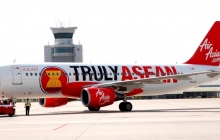AirAsia was launched in 2001 with the dream of making flying possible for everyone. Since then, AirAsia has swiftly risen to become the world’s best...
-

Agriculture
Where to invest?
Agriculture
ASEAN is one of the most productive agricultural baskets in the world. In 2022, the region produced 195.5 million tons of rice, 44.7 million tons of corn, and 82.1 million tons of cassava. Rice production this year is forecast to increase by 0.95% by 2023 to 202.34 million tons.1
Rice exports, domestic utilization, and self-sufficiency ratio are all expected to increase in 2024. ASEAN is likely to increase exports to 8 million tons.2 While domestic utilization is projected to increase to 115.82 million from 113.94 million tons in 2023, self-sufficiency (production to domestic utilization) ratio is still assured at 130.07 million tons, up from 128.9 million tons.3
No boundaries
Despite being leading producers of staple crops and food, most ASEAN countries are yet to reach their production boundaries. Investors, leveraging on the region’s balanced climate, fertile lands, and mix of lowlands and uplands, forests, rivers, and coastlines, are likely to find opportunities not just in crop and livestock production but also in managing food supply chain, agriculture infrastructure and safety, and agribusiness.
Investment space are expanding in terms of providing needed infrastructure to increase and climate-change-proof crop production, professionalizing and systematizing small-scale food processing, driving high-tech agribusiness, and other activities along the value chain.
Growth drivers
Optimism is high on the growth of the agriculture sector in the region. The ASEAN region is home to nearly 700 million people while its main food markets, East Asia and South Asia, have populations of 1.6 billion people and around 2 billion people,4 respectively. A large chunk of these populations form part of the growing middle class with increased buying capacity and changing preference from food staples to high-value food whether organic or processed.
ASEAN can act as the supply base for its larger neighbors. The region’s proximity to world powers like China and Japan puts it in a very good position for supplying food and other perishable goods. As the region itself continues to rise together with Asia’s economic growth, intra-market trade of goods is also expected to rise.
Towards regional integration
The agricultural sector is continuing its efforts to achieve its target for the ASEAN Economic Community in 2015 through increased efforts to ease trade between member states, allowing faster movement of perishable goods across long distances. The plan is to develop niche-based agriculture, and support it with reduction of trade barriers and construction of needed infrastructure.5
Myanmar, Thailand, Laos, and Cambodia of the Great Mekong Sub-region, which have adequate water supply and lowland areas for tropical agriculture, have placed major emphasis on internal transportation routes to facilitate movement of agricultural and food supply. For instance, the Ital-Thai company is looking at a US$ 48 billion deep-sea port and special economic zone project in Dawei (Tavoy) that will ease the trade of goods from the east directly to the Indian Ocean.
In the Brunei-Malaysia-Indonesia-Philippines (BIMP) growth area, physical integration is as important. A Roll-On, Roll-Off (RORO) vessel service that commenced its operations between Davao (Philippines) to Bitung (Indonesia) in 2017.6 The Philippines, Mindanao in particular, offers perfect agro-economic condition and several ideal areas for a wide range of crops. While Brunei, Indonesia, and Malaysia stand out as producers of industrial crops.
Region-wide, priority is given to the ASEAN Highway Network which involves upgrading of below Class III roads in designated Transit Transport Routes, and completion of the Singapore Kunming Rail Link which is intended to link seven ASEAN countries (Singapore, Malaysia, Thailand, Cambodia, Viet Nam, Myanmar, and Lao) to China.
-
ASEAN’s geography and climate are perfect for agriculture. Natural resources abound in this side of the world. Crop possibilities are endless. Find out the opportunities in agriculture production, post harvest processing, trade, and agribusiness.
SUCCESS STORIES
-
- Site Map
- Terms & Abbreviations

